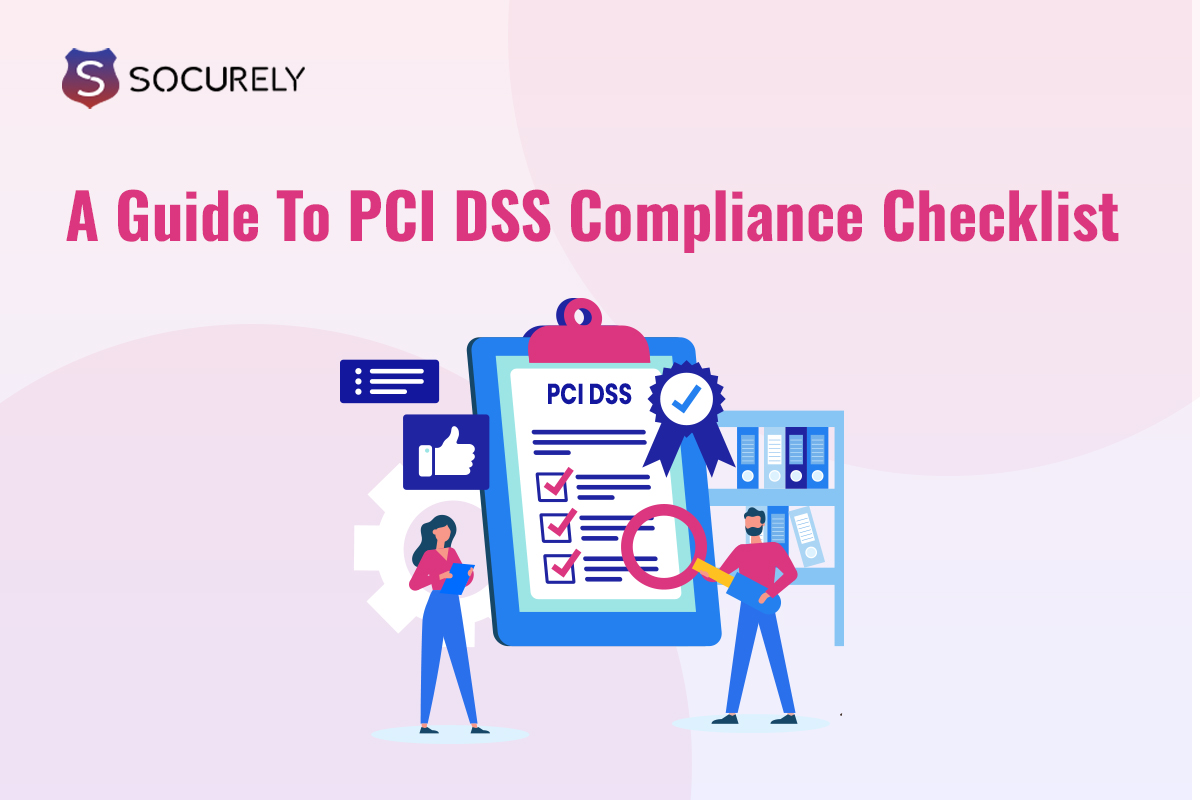In 2021, over 1.6 billion records were exposed through data breaches. With cyber threats on the rise, businesses handling card payments must prioritize securing sensitive data. This is where PCI DSS compliance becomes crucial.
But, one thing is immediately evident from a cursory review of the 300+ controls, 12 PCI DSS requirements, and 6 control objectives, PCI DSS compliance is not a cakewalk.
To streamline the process, we developed a checklist that walks through each of the 12 requirements and identifies important policy, procedure, and implementation elements.
So let’s begin.
What Is PCI DSS Compliance?
PCI DSS (Payment Card Industry Data Security Standard) is a set of security standards designed to ensure that all companies accepting, processing, storing, or transmitting credit card information maintain a secure environment. These PCI DSS standards stood by major credit card companies to protect cardholder data and reduce fraud. It is majorly required by any business, startup, or enterprise that performs credit card payments.
What Is The Purpose Of PCI DSS?
The primary purpose of PCI DSS is to safeguard sensitive cardholder information from breaches and cyber attacks. PCI DSS Compliance helps businesses protect customer data, avoid hefty fines, and maintain their reputation in the marketplace. It’s not just about avoiding penalties; it’s about establishing trust with your customers.
What Are Included In the PCI DSS Compliance Checklist?
PCI DSS Levels
There are four PCI DSS compliance levels, and the degree to which you comply will determine how strict the rules are:
- Level 1: Handles more than 6 million transactions a year; every entity classified as Level 1 by VISA ought to put in place Level 1 grade controls.
- Level 2: Handles between one and six million transactions per year. It is necessary to develop policies and apply level 2 grade controls.
- Level 3: Handles 20,000 to a million e-commerce transactions annually. The application of policies and level 3 grade controls is necessary.
- Level 4: Handles firms that handle up to 1 million total transactions annually and up to 20,000 e-commerce transactions annually. It is necessary to put Level 4 grade regulations and procedures into effect.
These PCI DSS Levels determine the different reporting obligations.
Level 1 businesses must submit a Report on Compliance (ROC) and submit to an on-site inspection by a Qualified Security Assessor (QSA).
Merchants at levels 2, 3, and 4 can submit an annual Self-Assessment Questionnaire (SAQ).
To guarantee the protection of sensitive data, Approved Scanning Vendors (ASV) must perform quarterly vulnerability scans at all levels.
PCI DSS Compliance Checklist
For the PCI DSS Compliance checklist, 12 PCI DSS Requirements help you to prepare forthe compliance. Each requirement is designed to protect cardholder data and ensure the security of payment card transactions. Here’s a detailed breakdown of each requirement:
Requirement 1-
- Installing and maintaining a firewall
- Goal- Securing networks and systems
An internal firewall divides your trusted network from untrusted networks, such as the Internet, through a barrier. This requirement ensures that firewalls are properly installed and configured to block unauthorized access and protect sensitive cardholder information.
An effective firewall needs to:
- Limit access to the business environment to authorized traffic solely by filtering it.
- Reject all unwanted traffic access automatically.,
- Safeguard all of your wirelessly linked point-of-sale equipment.
- Permit every outgoing request from your environment for storing business cards.
- Keep an automatic record of every modification made, even when authorized parties make changes in corporate settings, and provide justification for the change’s necessity.
Requirement 2
- Remove vendor defaults for security parameters
- Goal: Follow up with a secured network and systems
Default passwords and settings provided by vendors are often well-known to hackers. Changing these defaults to unique, strong passwords and settings reduces the risk of unauthorized access to your systems.
Requirement 3
- Protect stored cardholder data
- Goal: Protection of cardholder data
This requirement involves encrypting cardholder data when it is stored. Encryption ensures that even if data is accessed by unauthorized individuals, it cannot be read or used without the appropriate decryption key. It also mandates the masking of PAN (Personal Account Number) which only makes the few digits of the digital card visible.
Requirement 4
- Encrypt payment data transmission
- Goal: Protect cardholder data
When cardholder data is transmitted over open, public networks, it must be encrypted to prevent interception by malicious actors. It must get protection from malicious software when transmitted via open, closed, private, and public wireless channels. Strong encryption methods ensure that data remains secure during transmission.
Requirement 5
- Regularly update your antivirus software
- Goal: Maintain a vulnerability management program
Malware can compromise your systems and expose cardholder data. Here just installing regular antivirus software will not prevent the risks. Regularly updating antivirus software and conducting scans helps detect and eliminate malware, keeping your systems secure. Also, another way is to install advanced antivirus solutions across servers, firewalls, laptops, desktops, and mobile devices with access to business environments.
Requirement 6
- Establish secure systems and applications
- Goal: Maintain a vulnerability management program
To check every detail of your current security systems it is recommended to follow the risk assessment, which also shows which areas need updating. A robust security posture is ensured in these regions by implementing new security measures.
This requirement involves regularly updating software and applications to address security vulnerabilities. Patching and upgrading systems prevent attackers from exploiting known weaknesses in business environments like servers, POS devices, POS operating systems, laptop and desktop operating systems, and firewalls.
Requirement 7
- Restrict cardholder data access
- Goal: Implement strong access control measures
The seventh requirement addresses the management and restriction of access to sensitive user data by companies. Strong employee access control procedures should also be put in place. For instance, seniority, a legitimate need to access confidential information, or job-role-based classifications could all be taken into account when granting access. Organizations must also routinely check access logs and document their access control protocols by this criterion.
Requirement 8
- Assign unique user IDs and passwords
- Goal: Implement strong access control measures
Each user should have a unique ID and strong password. This not only enhances security but also ensures accountability by tracking who accesses what data and when.
Requirement 9
- Restrict physical access to cardholder data
- Goal: Implement strong access control measures
Physical access to systems that store or process cardholder data should be restricted. This includes securing access to buildings, rooms, and storage devices to prevent unauthorized individuals from gaining physical access to sensitive information. RFIDs (Radio Frequency Identification) should be used to implement measures to prohibit unlawful physical access to assets, and access to physical data should be restricted.
Requirement 10
- Track and monitor network access
- Goal: Regularly monitor and test networks
Implement logging mechanisms to track all access to network resources and cardholder data. Monitoring these logs helps detect and respond to unauthorized access attempts in real time. Every firm must maintain time-synchronized audit trail recordings of all network operations going back a year to comply with this PCI compliance criterion.
Requirement 11
- Test security systems and processes
- Goal: Regularly monitor and test networks
Regular testing of security systems and processes, such as vulnerability scans and penetration testing, helps identify and address security weaknesses. This proactive approach ensures that your defenses remain effective against emerging threats. Also, they should scan their external facing domains and IPs with the help of a PCI approved scanning vendor (ASV).
Requirement 12
- Establish and maintain an information security policy
- Goal: Maintain an information security policy
Develop a comprehensive information security policy that addresses all aspects of data security. This policy should be regularly reviewed and updated to reflect changes in technology, business processes, and the threat landscape.
Why Implement PCI DSS Checklist?
Benefits of PCI DSS Checklist
- Boosting Customer Confidence
- Streamlining Internal Processes
- Facilitating Global Business Operations
- Enhancing Third-Party Vendor Management
- Reducing the Likelihood of Data Breaches
- Improving Incident Response Preparedness
- Boosting Customer Confidence
Adhering to PCI DSS standards signals to your customers that you are committed to protecting their payment information. This can enhance your company’s reputation and increase customer trust, leading to greater loyalty and repeat business.
- Streamlining Internal Processes
The rigorous requirements of PCI DSS often lead to more efficient and organized internal processes. This streamlining can result in operational efficiencies, reduced redundancies, and improved overall productivity.
- Facilitating Global Business Operations
For businesses looking to expand globally, PCI DSS compliance can simplify the process of meeting international security standards. This is particularly important as different countries have varying data protection regulations, and PCI DSS can serve as a comprehensive baseline.
- Enhancing Third-Party Vendor Management
The PCI DSS checklist includes requirements for managing third-party vendors who have access to cardholder data. This can lead to better oversight and risk management when working with external partners, ensuring they also adhere to high-security standards.
- Reducing the Likelihood of Data Breaches
While no system can be completely secure, PCI DSS compliance significantly lowers the risk of data breaches. The comprehensive nature of the standards means that vulnerabilities are more likely to be identified and addressed before they can be exploited.
- Improving Incident Response Preparedness
PCI DSS requirements include having an incident response plan in place. This ensures that your organization is prepared to respond quickly and effectively to a data breach, minimizing damage and recovery time.
The Future Revealed With PCI DSS
The most recent version of the PCI DSS compliance framework, version 4.0 (V4), was released in March 2002, taking the place of version 3.2.
The primary goal of PCI DSS V4 is to encourage security as an ongoing endeavor-
- There are now roles and responsibilities allocated to each need.
- There will now be guidance provided to comprehend, apply, and uphold security.
- With enhanced places to showcase enhancements, the report section offers more transparency than before. For readers of the report, that’s a victory.
User card data security techniques need to adapt to the ever-changing security environment. The PCI DSS 4.0 includes the following new updates:
- There are stricter MFA (Multi-Factor Authentication) requirements.
- The prerequisite containing the password policy details has been updated.
- To address phishing and e-commerce, new guidelines have been introduced.
- Enhanced adaptability enables enterprises to accomplish their security objectives with novel approaches.
Accounts that are shared, public and group are now permissioned.
- Currently, risk analysis is the focus. This enables companies to determine how frequently they would like to conduct risk analyses.
- Nowadays, customization plays a role in determining how businesses meet their security and compliance objectives.
The Socurely Way
Achieving PCI DSS compliance is not just a regulatory requirement; it’s a strategic move to protect your business and customers. By following the PCI DSS checklist, you can ensure that your organization is secure, trusted, and prepared for the future of digital transactions.
Socurely can guide you through the complex process of achieving PCI DSS compliance. With our expertise, we help you implement the necessary controls, conduct thorough assessments, and prepare for audits. Partner with Socurely to secure your business and protect your customers’ data.
FAQ
Is PCI DSS Compliance mandated by law?
It is not legal to comply with PCI. However, it is required under the terms of the contracts that major credit card companies like American Express, Visa, Mastercard, Discover, and JCB have with payment processors.
What are the common PCI DSS violations?
Insecure data transmission, insufficient network segmentation, lax access controls, default passwords, and unfinished security policies are a few frequent PCI infractions.
Is it possible to hire a third party to process cardholder data?
Yes, as a merchant, you have the option to assign cardholder data processing to a third party, but you still have the final say over what happens. To guarantee secure transmission of cardholder data, choosing a provider who complies with PCI DSS is essential.







